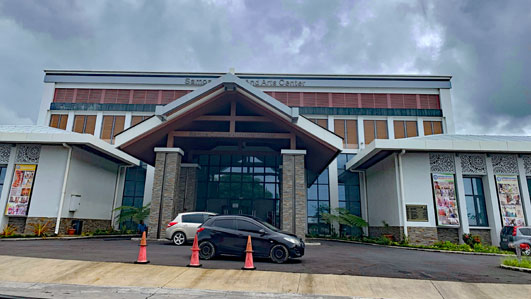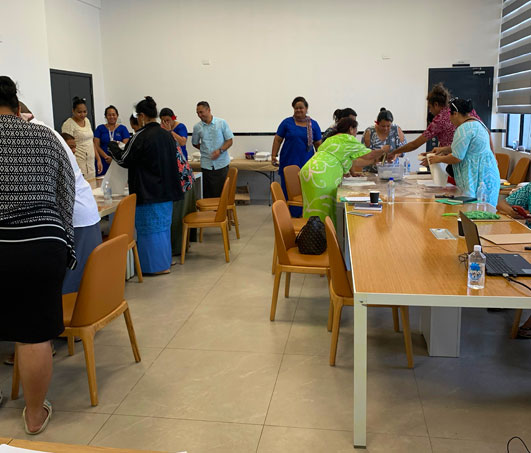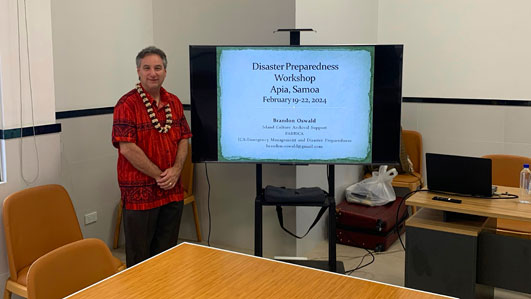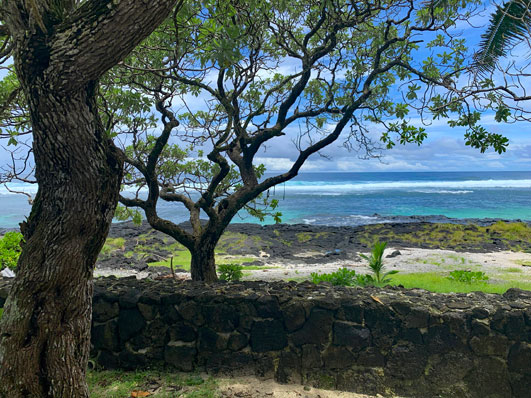Disaster Preparedness WorkshopUpolu & Savai'i, Samoa February 19-22, 2024

I was honored to conduct Disaster Preparedness Workshops in Apia on the island of Upolu, Samoa. The workshop was originally slated for August 2023, but it had to be postponed. A new Terms of Reference was created in January 2024 with the training occurring in February.
The goal of the Disaster Preparedness Workshop in Samoa was to examine the three basic stages of disaster preparedness: preparedness, response and recovery, and to learn how to write a Disaster Preparedness Plan. The workshop helped participants to consider all situations and levels of a disaster impact particularly those that cause damage to records, collections, assets, and disruptions of the flow of business and services. Additionally, participants learned how to be more proactive in the areas of before, during, and after a disastrous event occurs. Thus, the workshop first focused on the topics: What a disaster is and the reasons that a Disaster Preparedness Plan is needed. Then the rest of the workshop was spent on how to write the plan. The topics that were covered included risk assessment, reducing risks, knowing your vital and significant records, response techniques, disaster team planning and supplies, salvage priorities, staff responsibilities, recovery efforts, and resources.
While each organization plans for evacuating buildings, protecting people and property, the same care and attention to planning should be placed on the collections, records, assets, and cultural history. Participants, therefore, will be able to benefit by applying what they have learned in the workshop towards disaster preparedness at their respective organizations. The workshop also provided participants the opportunity to learn about resources within their community and region that they can add to their disaster preparedness plan.
The theme of the workshop was: "Be Proactive." A Powerpoint presentation guided the training, and it included exercises and a hands-on tutorial on handling wet materials. The exercised involved a Risk Assessment of the risks that could compromise the organization's collections and buildings. These could be in the form of a natural disaster, or by risks within the building itself such as, pest, leaky roofs, or faulty plumbing. The second major exercise was participants evaluating their significant records and trying to decide that if a disaster struck, which collections or records would be saved first. This exercise wasn't as easy as it sounds because we are led to believe that all records are important. But by knowing which collections and records are the most important, valuable time would be spent on salvaging the important records first. By the end of the workshop participants were able to:
- Formulate their own disaster management plan;
- Learn the proper techniques for response;
- Learn the proper techniques for recover; and
- Identify and build a local and international support network.

The first three workshops were conducted on Monday, Tuesday, and Wednesday at the Samoa Culture and Arts Center. The Samoa Ministry of Education, Sports, and Culture and the National Archives and Records Administration (NARA) sponsored the workshops. Approximately fifteen participants partook in the workshop each day. Most of the members were from one of the many Samoan Ministries who were in charge of managing and safeguarding records before they become archives and sent to the National Archives. Other participants that joined the training were members of an Archives in the private sector such as one of Samoa's universities.
Each of these workshops opened at 9:30 a.m. with comments and a prayer by Simi Tanielu, Principal Digitization Officer of NARA, followed by remarks from Amela Silipa, National Archivist of Samoa. I then took over and conducted the workshop from 9:45 a.m. to 12:00 p.m. A hearty lunch was then served for each of the participants. After lunch, group photos, closing remarks, and certificates were passed out to all of those who were in attendance.
After the workshop on Wednesday, a small team from NARA and myself caught the ferry to the town of Salalologa on the island of Savai'i where we would conduct the training the following morning. The workshop was held in an upstairs meeting room at the public library. Approximately twelve people attended the training from different Ministry offices. When the workshop ended, participants received certificates and lunch was provided. Then, we returned to Apia by catching a late afternoon ferry.
Because disaster do not occur every day, creating disaster preparedness plans are not typically on the priority "to do" list in organizations. The workshop seemed to come at a perfect time. In fact, some of the trainees had been already given the job of writing their disaster preparedness plan and the workshop definitely provided the information that they needed to complete their task. Overall, I believe that the workshops went extremely well throughout the week. NARA staff did a remarkable job of making the trainings go efficently. Participants were engaged and interested, and the exercises prompted lively discussions. They were also pleased knowing that they could receive a copy of the Powerpoint presentation that guided the training along after the workshop.
A special thank you for making these workshops a success goes to the NARA staff, particularly: National Archivist, Amela Sipia, Principal Recordkeeping Officer, Vaveao Toa, and Principal Digitization Officer, Simi Tanielu. This group truly worked hard planning to make these workshops run smoothly. I know that there was a lot of behind the scenes tasks and I appreciate all the hard work that was done in the past several months. I would also be remiss for not giving a sincere thanks to NARA staff members, Linna Misimoa, Senior Recordkeeping Officer and Ana Patolo, Senior Quality Control and Assurance Officer. These two were a big help during the trainings. Finally, another hearty thank you should be given to the Samoa Ministry of Education, Sports and Culture for approving the workshops and allowing them to take place at the Samoa Culture and Arts Center.

Recommendations:
During the workshops throughout the week, there were a few issues and concerns that arose that are worth examining and sharing. These issues can be turned into recommendations for NARA (and organizations) moving forward with developing their Disaster Preparedness Plan:
- Disaster Preparedness Plans should include collections, records, and assets
Many Ministries already have a Disaster Plan in place, but they often do not include collections, records, and assets such as computers, servers, objects, and possibly works of art. It was good to see that a few Ministry record keepers who attended the workshop were tasked with writing a plan that will include their collections, records, and assets. However, this attitude needs to be collectively changed throughout all the Ministries that house records. - Workshop Follow-up
I have conducted many workshops worldwide at various conferences, or onsite at different organizations. Some were well attended, while others contained a sparse crowd. Be that as it may, I always believed that there should be some kind of a way to improve the follow-up with participants because when they return to their jobs they quickly become too absorbed with their duties and every day life that they forget to incorporate what they have learned and apply the new knowledge into formulating their disaster plan. Some participants have been charged to write their plan, while others are not. Nevertheless, follow up needs to be established.
Because the majority of the attendees of the workshops in Samoa were from a Ministry, I recommend that the appropriate staff (or disaster committee) from the National Archives and Records Administration (NARA) be responsible for following up with the Ministries. After all, those records deemed archival will eventually come to NARA. First, however, a small disaster committee from NARA needs to be assembled. This group will write their Disaster Preparedness Plan. Then, they could use their plan as a model or template to help the Ministries write or complete their plan. The NARA disaster committee could also run training sessions in the near future to those Ministries who did not attend the workshop and are in need of formulating and writing a plan. - NARA Disaster Committee should conduct future Disaster Preparedness training sessions
Since not all the record keepers from all the Ministries were able to attend the training, there should be a training that includes those who missed in the near future. Thus, I recommend that the NARA disaster committee continue to run training sessions to those personnel from Ministries who did not attend the workshop and are in need of formulating and writing a plan. This could be a once a year event. Additionally, because The National Library and the Public Library on the island of Savai'i are under the direction of NARA, these libraries should also be included in training and assistance from the NARA disaster committee when formulating a Disaster Preparedness Plans. - Digital Preservation
When I have conducted workshops on Disaster Preparedness Planning in the past, the question of how to include digital records in the disaster plan is frequently asked. Typically, the current suggestion is to ensure that assets such as computers, servers and hard drives are responded to and salvaged by moving these items to a safer place. Naturally, this could only be done before and during a risk. However, after a disaster strikes, it may be a bit more difficult to salvage digital material from computers and servers. Therefore, I recommend that digital preservation play a major role in the disaster plan. This may mean participating in digital preservation trainings that are offered online or at conferences and learning how to create backups and techniques for migration. - Samoa's Private Sector
There were a few attendees at the workshop who were from the private sector such as the National University of Samoa. These organizations will also need to be followed-up after the workshop. I do not believe, however, that following up with the private sector should fall under the responsibility of the NARA disaster committee. Instead, I might have to take the initiative to return to Samoa and help interested private organizations to write their Disaster Preparedness Plan. Most likely, I would start with the libraries at University South Pacific, and the National University of Samoa. - Budget
Preparing a disaster preparedness plan cannot be done without having some expense. Costs can add up with the purchase of a disaster bin (or two), as well as it could be expensive to buy supplies that are needed for salvaging collections. Other expenditures could include hiring professional contractors and equipment that will be needed to get the organization back to normal operations after a disaster has struck.
Therefore, it is recommended that the disaster planning committees look into creative, yet practical ways to acquire the necessary funds to put towards the disaster plan.
- Ask for donations - the Ministry of Education, Sport and Culture is in a unique position to ask for donations. Donation boxes could be set up at cultural places where tourist frequent. Museums, Cultural Center, any other spot that is under the Ministry could be used to ask for donations for specific projects including a disaster preparedness supplies for collections. This may not be feasible, but it is certainly worth looking into. There could also be a "Call to Action" on the Ministry's Facebook and other Social Media pages particularly for specific
- Buy materials when they are on sale or at discounted stores - Disaster supplies such as paper towels or gloves could be bought in the various Chinese stores around the island.
- Do what risk mitigation you can do in anticipation of any disaster - Writing the Disaster Preparedness Plan will help identified risks. Many of these risks could be dealt with before a disaster happens. However, as some of these risks could be reduced they may have costs, but these costs may be more affordable than after a disaster strikes. Putting a budget towards building and collection maintenance is not only prudent, but is necessary for the success of the disaster plan.
- Advocate and make the business case to senior management - Creating a Disaster Preparedness Plan will require support from upper management. This may have to be done consistently as there are monetary issues involved with disaster planning and salvaging. Be ready with evidence, research, and data to make a bid for more budget. Combining the argument for resources with advocacy to everyone who comes into contact with the archives and even in staff and volunteers' social circles will ensure that the community understands the value of the archives and the need for assistance to protect and rescue them in the event of a disaster.
It is important to remember that any action or reaction, even a small one to disaster preparation, is better than no action at all. In developing your disaster plan, regardless of the size of your budget, try to think creatively. Disaster planning is not a rigid standard. It is a very practical exercise.

